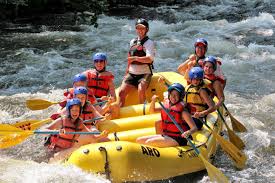compared
Rafting
 Raft is an inflatable raft boat for rafting on rivers. Rafting is an alloy on rapids on inflatable ships. Raft is an elongated oval, designed for several people at once. They mainly hold on to it with their feet, sticking them into special loops like stirrups, since the hands are busy with oars during the rafting.
Raft is an inflatable raft boat for rafting on rivers. Rafting is an alloy on rapids on inflatable ships. Raft is an elongated oval, designed for several people at once. They mainly hold on to it with their feet, sticking them into special loops like stirrups, since the hands are busy with oars during the rafting.
Coordinated rowing is very important in rafting alloy, otherwise the boat will turn the boat rapidly around its axis.
The raft has a captain (instructor), without which rafting is impossible. This is a rather dangerous sport and entertainment, so the captain does not tolerate objections from sailors.
Rafting is widespread almost everywhere where there is the possibility of rafting along the rivers. The World Rafting Championships take place on the African Zambezi River, slightly downstream of the famous Victoria Falls. Continue reading
Mountain tourism
 Mountain tourism is a fairly extensive category of outdoor activities. It includes trips to highlands, rock climbing, caving, rafting on mountain rivers, geological explorations, expeditions to familiarize yourself with the flora and fauna. According to the official definition of the World Tourism Organization, mountain tourism is the overcoming of routes running at an altitude of at least 3 thousand meters above sea level. In accordance with this interpretation, in Ukraine there are no mountains of such height that travel on them could be qualified as mountain tourism. For example, the highest point of the Carpathians, Mount Goverla, has a height of 2600 m, and the most significant peak of the Crimea, Mount Roman-Kosh, is located at an altitude of 1545 m.
Mountain tourism is a fairly extensive category of outdoor activities. It includes trips to highlands, rock climbing, caving, rafting on mountain rivers, geological explorations, expeditions to familiarize yourself with the flora and fauna. According to the official definition of the World Tourism Organization, mountain tourism is the overcoming of routes running at an altitude of at least 3 thousand meters above sea level. In accordance with this interpretation, in Ukraine there are no mountains of such height that travel on them could be qualified as mountain tourism. For example, the highest point of the Carpathians, Mount Goverla, has a height of 2600 m, and the most significant peak of the Crimea, Mount Roman-Kosh, is located at an altitude of 1545 m.
Mountain tourism in the Krim and Carpathian mountains Continue reading
About the varieties, motives and benefits of travel
 According to the Dictionary of the Russian Language of Sergei Ivanovich Ozhegov, travel is a trip or walking on foot to distant countries, places.
According to the Dictionary of the Russian Language of Sergei Ivanovich Ozhegov, travel is a trip or walking on foot to distant countries, places.
Everything seems to be clear, but immediately the question arises of what can be considered “distant countries and localities”. The concept of “distant” is always relative. For one person, distant terrain begins one kilometer from home, for another five hundred. For a child, it can start in a neighboring yard.
It turns out that just “range” is not enough to determine the journey. The problem disappears by itself if the concept of “distant terrain” is supplemented with such characteristics as uncharted, unstudied. Going to new places unknown to him, a person creates a travel situation. Continue reading




